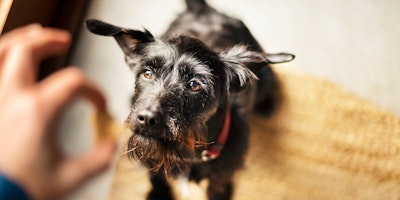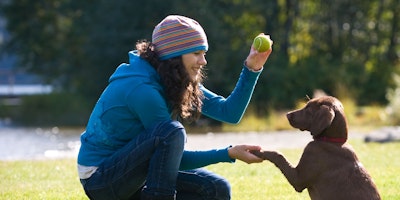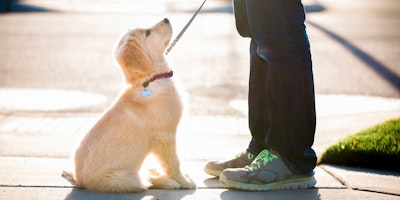
For dog owners who have just brought home a new puppy, crate or kennel training should be a top priority.
Teaching your dog to use their crate not only helps housetrain puppies, but it also offers them their own space. Dogs find comfort sleeping in small, enclosed spaces. Think of a crate as a relaxing area where they can unwind and have some alone time.
Why Crate Training Is Important
The goal of crate training is for your dog to spend time in the crate when you’re away. Keeping your dog in a crate while you’re away will help set boundaries as well as keep them from going potty on the carpet. Dogs usually don’t like to relieve themselves in the same place they sleep.
Crate training can also get your dog used to being in a crate for air or car travel. In fact, dog owners may want to research FAA-approved crates so they can double as an at-home or travel dog crate. Another advantage of getting your puppy or dog used to their crate is it can help keep them in place if they have an injury that requires you to restrict their movement.
How Big Should a Dog Crate Be?
You want to choose a crate that’s cozy but not so small that your dog doesn’t have room to maneuver. When learning how to kennel train a puppy, the first step is finding a crate that gives your dog enough room to stand up and turn around.
If your dog has to force itself into one position to get in, it’s too small. However, if a crate is too big, your puppy may decide to use one part of the crate to relieve themselves and another part to sleep. Add a pad or a blanket to make your dog’s crate a comfortable place.
Note that the easiest crates to clean are wire or plastic crates. Puppies who go outside often may not have accidents in their crates, but an easy-to-clean option may be best until fully potty trained.
A crate is a place your puppy or dog will use for relaxation. To avoid any distractions, it should be somewhat dark and den-like enclosure. Hard-sided crates are good at blocking out the light, but if you opt for a wire crate, drape a blanket or towel over it, so it’s cozy and inviting while making sure there’s enough air flow.
Crate Training Tips for Puppies
If you’re wondering how to crate train a puppy in a few simple steps, try the following:
- Find a permanent location for the crate, somewhere close to where you or other people in the home spend lots of time, yet in an area where there is some privacy.
- Introduce your puppy to the crate in a low-stress situation—not when you’re about to leave. Toss in a treat or some dog food and praise your puppy when they enter the crate. Keep the door open to allow them to move around and explore.
- Remove their collar before putting them in, as you don’t want the collar to get stuck on a part of the crate.
- Put a treat in the crate and use simple words like “kennel” or “crate” to get them used to the command.
- Try giving your dog a chew toy to reward your dog when they start to spend more time in the crate. This will help them relax and engage in an activity they enjoy.
- Try feeding your puppy in the crate to create a positive association.
- Do not use a dog crate as a form of punishment. This will make your dog not want to use their crate.
- Gradually increase crate time with the door closed. Start by closing it for only a few moments, then work your way up. Make sure to praise them after you close the door.
- Don’t open the door if they start to whine. That will only teach them that whining will get them out of the crate.
- Puppies younger than 10 weeks can hold their urine for about an hour. By 12 weeks, they can hold it for about 2. It gradually increases over time, and when they around six months of age, they can hold it for five to six hours.
- No matter their age, try to avoid leaving them in their crate for more than eight hours. Long stretches of time in their crate can be difficult, both physically and mentally. Remember, the longer your dog stays in the crate, the more exercise they’ll need when you let them out. If your dog has been in a crate for several hours, make sure they get extended playtime afterward.
How to Crate Train an Older Dog
Learning how to crate train a dog that’s older is similar to crate training a puppy. While older dogs may tend to be a bit more set in their ways, a little bit of patience, some tasty incentives and lots of praise will make all the difference.
Crate Training Tips for Older Dogs
- Make sure your dog is relaxed before crate training and has been outside to relieve themselves recently.
- If your dog is not relaxed, take them out to get some exercise, then try again.
- Ensure your dog’s crate is cozy and comfortable with a pad or blankets to lay on.
- Place treats or toys just inside the opening of the crate and let him retrieve them while saying things like “kennel” or “crate” to get them used to the command.
- Try feeding your dog while they’re in the crate so that they associate their crate with positive things.
- After your dog has grown more comfortable with the crate, try to place treats or toys further inside. See if they are comfortable going all the way inside.
- Once your dog is comfortable going inside the crate, try closing the door, but just for a few seconds. Then open it.
- Over time, keep the door closed for longer and longer periods as your dog adjusts.
- Give lots of praise throughout the process.
These steps should get your dog used to spending time in their crate in no time.
For more tips on dogs and puppies, hear from our pet experts on our Pet Expertise page.
Related articles


Be Rewarded for Your Purina Purchases
Earn and redeem points for Purina products with myPurina app.


